6 Benefits of Using Restaurant Reservation Software for Table Bookings
In the fast-paced world of the restaurant business, managing reservations can sometimes feel like a juggling act.
Missed bookings, accidental overbookings, and unoptimized seating arrangements can all contribute to inefficiencies, causing frustration for staff and guests and ultimately reducing your establishment’s reputation and bottom line.
This article aims to provide a solution to some of these challenges by focusing on how restaurant reservation software and its many benefits can simplify operations and streamline the booking process—enhancing guest satisfaction, improving staff efficiency, and boosting revenue as a result.
So, if you’re ready to learn more about this technology and transform your restaurant business, read on and learn about the first advantage—attracting more customers!
Attracts More Customers
A great restaurant reservation system will have a variety of features and characteristics that you can leverage to attract more customers to your restaurant.
Imagine this—it’s late at night, outside your working hours, and a potential customer is planning their next lunch. They find your restaurant online and decide to book a table.This scenario is not so uncommon. In fact, data shows that almost half of appointments are made after business hours.
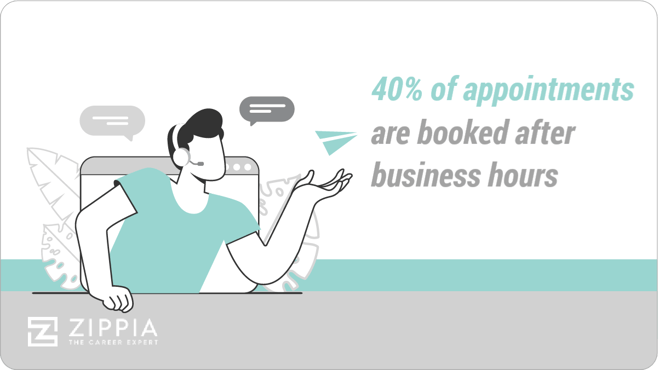
Source: Zippia
With over-the-phone or email reservations, your staff won’t be available to take the call at the consumers’ preferred time, missing out on a potential diner.
On the other hand, a good reservation system will always be available to take bookings, even on days when your restaurant doors are closed.
But 24/7 availability is only part of the story.
Reservation systems also offer a variety of features, like useful integrations that make it convenient for guests to secure a table from wherever they stumble upon your restaurant.
Let’s give you an example with our own restaurant reservation software, Tablein.
Known for its user-friendly and intuitive interface, Tablein is designed to make the booking process as simple as possible from your website, social media, or other online platforms.
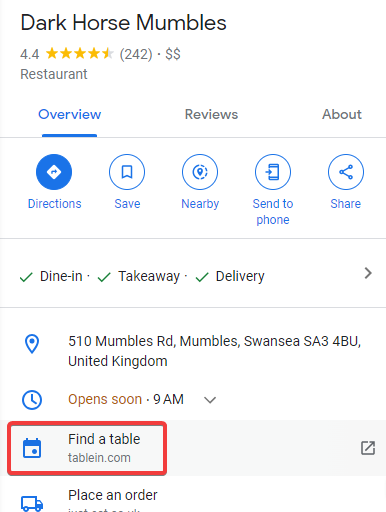
Source: Google
The screenshot above shows how Swansea’s Dark Horse Mumbles used Tablein to streamline table bookings by adding a Find a table link to their Google Maps profile.
A potential customer who finds this business while browsing local restaurants can open up the booking link and make a reservation in minutes.
What’s more, you can easily add this widget to individual Google Posts, which appear in the local panel on Google Search or Google Maps.
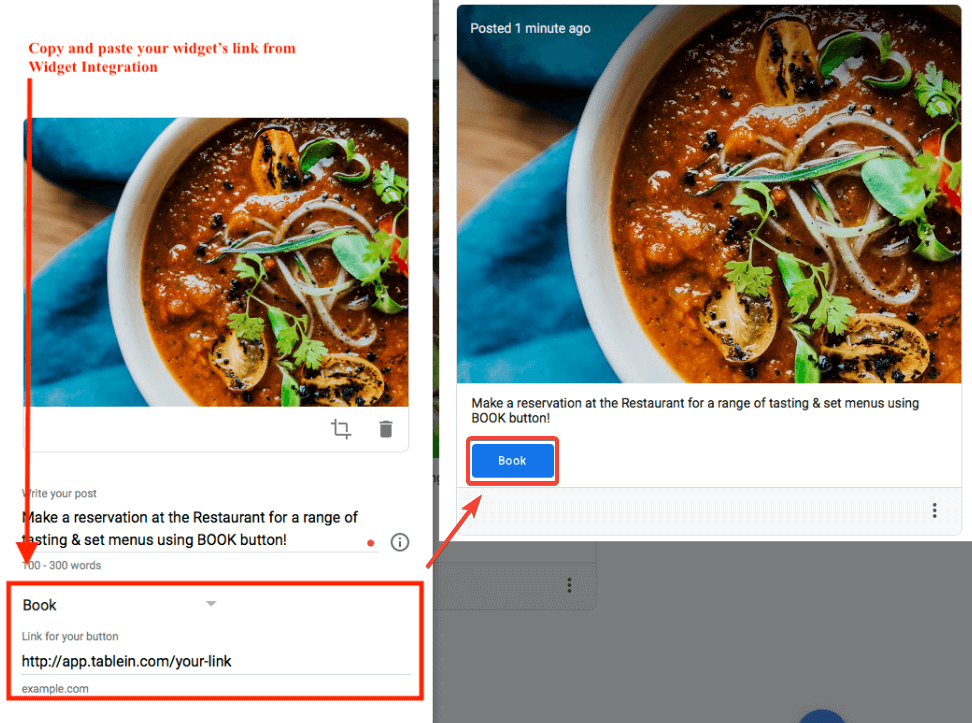
Source: Tablein
As you can see in the above image, integrating Tablein with these posts is done with a few clicks. Similarly, your guests will be able to book their table with the same amount of ease.
By offering potential customers simplicity, convenience, and round-the-clock availability, you will attract many more table bookings.
Ensures Accurate Reservations
As any seasoned restaurant owner knows, accuracy is key when it comes to taking and managing reservations.
In the hustle and bustle of the restaurant business, taking reservations can be a cumbersome task. If done manually, it can be slow, tedious, and, more often than not, susceptible to errors.
Misunderstandings with customers, bad handwriting, or hastily jotted down notes can create chaos.
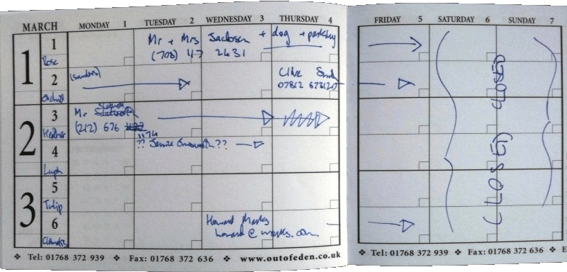
Source: Bruce Greig
Take a look at the image above. Can you decipher the scribbled notes quickly? Could you confidently confirm a reservation based on this? Our guess is—probably not.
Now, let's contrast this with a different scenario. Imagine an intuitive, clean reservation screen where guests can book a table themselves, like the one shown in the following image.
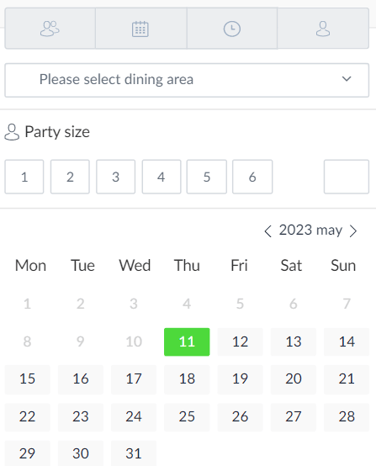
Source: Tablein
As you can see, guests can choose their preferred dining area, select the size of their party, and pick the date and time of their reservation with ease.
The simplicity of the process and the fact that guests will be careful in selecting their preferred reservation options can significantly lower the chances of inaccuracies.
But what about when your staff needs to book a reservation?
Well, the reservation screen of a high-quality reservation tool should be designed to be straightforward, making it effortless for your staff to navigate and reducing the chance of mistakes.
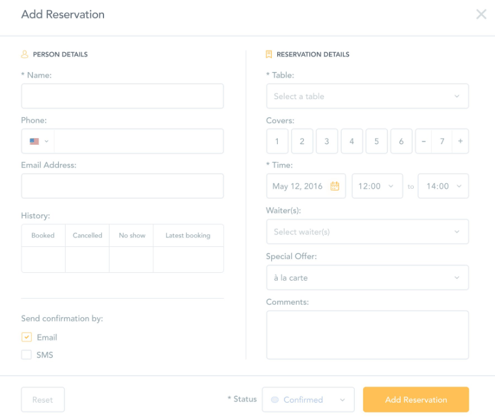
Source: Twitter
Just like the above image, a clean, well-organized reservation screen is a game-changer.
It allows your staff to enter reservation details quickly, minimizes potential errors, and ensures a smoother operation overall.
Plus, it enables your team to provide a higher level of service, as they can spend less time on administrative tasks and more time on customer service.
So, with reservation software, you can dramatically reduce the number of errors and elevate your customer service game.
Maximizes Table Turnover
One key benefit of reservation software is ensuring your eatery gets a steady flow of guests, aiding in optimal table turnover.
Table turnover is a critical consideration for restaurant owners, and increasing it should always be a top priority.
Essentially, it's all about maximizing the utilization of your available seating capacity to accommodate as many guests as possible, ultimately boosting your restaurant's profitability and success.
However, as one Quora user summarizes, this issue is more complex.

Source: Quora
As the user insightfully points out, restaurant owners must strike a delicate balance between profit and customer experience. This is where restaurant reservation software can play a powerful role.
It provides visibility and organization for your tables and reservations, assisting you in achieving this balance.
For instance, high-quality reservation tools should offer features where your staff can quickly check the status of individual reservations.
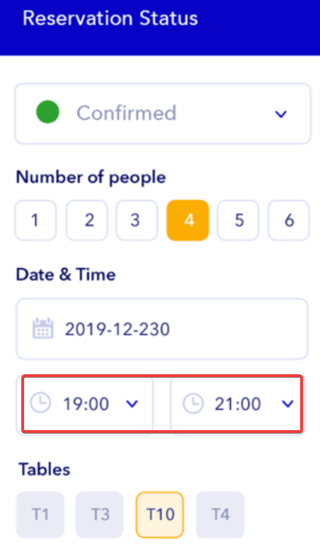
Source: Tablein
The above example shows a reservation status screen where staff can access essential details at a glance, such as the time of the reservation, the expected duration of the dining experience, and the table allocated for the guests.
This information empowers your staff to manage table turnover more effectively, thinking about the optimal time to seat new guests and avoiding guests having to wait a long time for a table.
Additionally, reservation tools should offer a table floor plan feature like the one shown below.
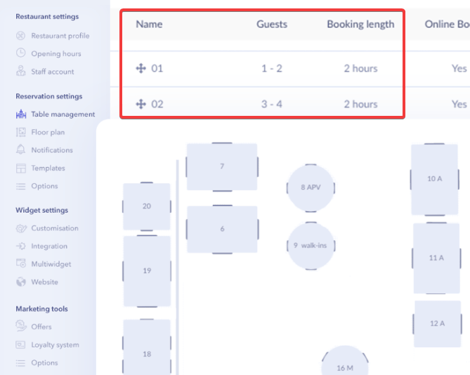
Source: Tablein
These floor plan features provide a complete overview of your restaurant's capacity, with the above example having a section that displays the entire list of reservations, the number of guests at each table, and the expected booking length.
A visual representation of all the tables should also be available, allowing staff to check each table’s status with a quick glance.
As you can see, implementing restaurant reservation software can help staff manage tables more optimally and efficiently, allowing you to accommodate more guests each night.
Improves Waitlist Management
No one likes to wait, especially hungry diners who've made an effort to visit your restaurant.
Luckily, another benefit of an effective restaurant reservation tool is improving waitlist management.
Effective waitlist management is all about maintaining a smooth and efficient flow of customers from the moment they enter your restaurant until they're comfortably seated.
It involves accurately tracking the waiting times and ensuring the next diner in line is promptly seated as soon as a table becomes available.
Traditional paper waitlists just don't cut it anymore. Filling them out is slow and it’s easy to make errors while you do it.
Worst of all, using them doesn't provide the kind of seamless experience your staff and customers deserve.
Just take a look at the next image.
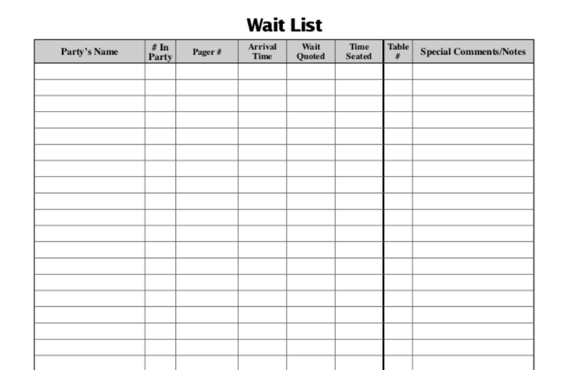
Source: Red Book Solutions
The image shows a typical paper waitlist.
Each walk-in guest that enters your eatery will need to be manually logged in by a staff member, which not only takes up their valuable time but also leaves a lot of room for mistakes.
It's easy to see why this system is far from ideal.
Now let's contrast this with a digital waitlist, one of the many features offered by restaurant reservation software, shown in the following image.
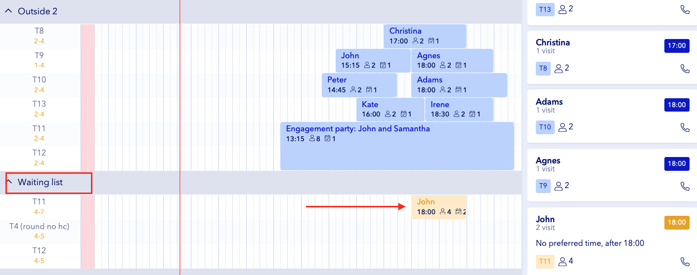
Source: Tablein
As you can see, both the occupied tables and the waitlist are visible on the same screen. As soon as a table is freed up, the guests next up on the waitlist can be seated.
Though staff will still enter the walk-ins manually, using a reservation system can lower mistakes and make everything go smoothly.
The process is straightforward, efficient and can greatly reduce the chance of errors.
Overall, this feature can significantly enhance waitlist management, enabling staff to efficiently handle guest queues and provide a smooth and organized waiting experience for guests.
Reduces the Number of No Shows
As you may know first-hand, the issue of no-shows can significantly impact a restaurant’s operations, but restaurant reservation software can help you tackle this problem head-on.
The reality is that no-shows are incredibly damaging to restaurants. They not only lead to lost revenue but also disrupt the flow of service and can greatly affect other customers' dining experiences.
Take, for example, this next tweet, showing an example of a problem one restaurant faced due to guests failing to arrive for their reservations.

Source: Twitter
This Twitter user writes about a common concern faced by restaurant staff—should they hold a table for late arrivals or seat eager guests on the waitlist? It's a frustrating situation for everyone involved.
Unfortunately, some restaurants handle no-shows poorly, as demonstrated in the next image.

Source: News
This restaurant canceled a potential guest’s reservation because they failed to re-confirm their booking after an initial confirmation was made.
Their way of discouraging no-shows led to a negative customer experience—so much so that the customer in our example wrote an entire opinion piece about it.
A far better approach is implementing a cancellation and no-show policy for your restaurant and using a robust restaurant reservation system to help enforce it effectively.
This approach makes diners think twice before skipping out on their reservation, as they stand to lose money if they don't honor it.
Just make sure to explain the cancellation policy in detail on your restaurant’s website and in the reservation tool itself, as was done in the screenshot below.
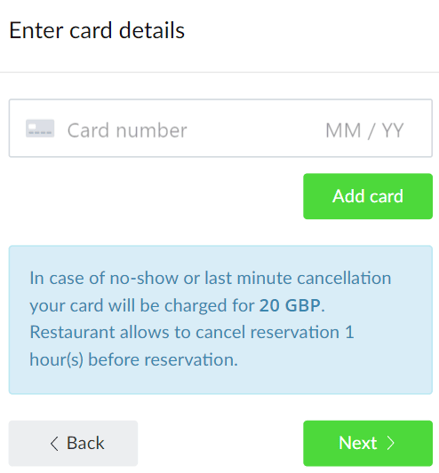
Source: Tablein
Besides informing guests about the potential no-show fees, a well-designed reservation tool can securely store guest card details and automatically deduct a certain amount in case of a late cancellation or a missed reservation.
Simply put, by enforcing and automating the late cancellation or no-show policy with a reservation tool, you can discourage guests from making impulsive reservations in a straightforward and clear manner.
Automates Customer Communication
Fostering stronger relationships and communicating with customers are great practices for the success of any business.
However, in the restaurant industry, these practices aren’t just nice to have, but they are absolutely essential.
The reason is simple—the quality of your customer relationships can significantly influence your restaurant reputation, drive repeat business, and ensure your overall success.
Consider, for example, the impact of a simple automated SMS message sent to guests right after they make a reservation.
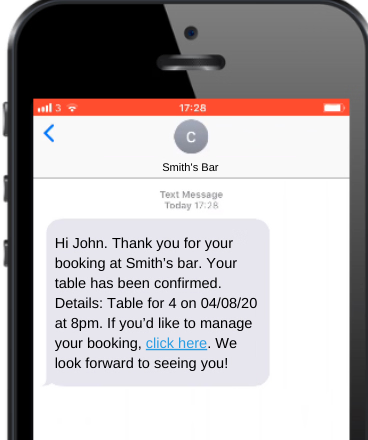
Source: Voice Sage
A message like this can be easily sent through a reservation system but be quite useful.
The SMS will remind guests of the booking details like the date, time, and number of people and offer them a quick and easy way of changing their reservation details by following a link.
This way, any errors in the booking details can be taken care of early on, avoiding guests getting frustrated down the line.
Confirmation texts are just one benefit of automated communication. A great restaurant reservation tool can also send booking reminders, feedback requests, no-show texts, and “table is ready” alerts.
All of these serve to enhance your relationship with customers and make their experience more enjoyable.
This communication isn’t limited to SMS, as emails can be equally, if not more, effective.
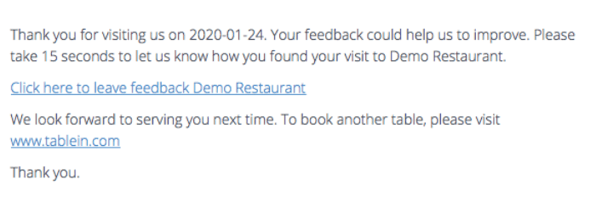
Source: Tablein
Take a look at the above image of a feedback email. This clear, courteous email can be automatically sent to guests after their visit, letting them know their opinions and experiences are valued.
It provides an opportunity for you to gain valuable feedback and ratings, which can further help you improve your service and offerings.
Like texts, various other types of emails can be sent to guests, and you’d do well to explore these options in your reservation tool and use them to their utmost advantage.
So, by automating your communication through well-designed features in your restaurant reservation system, you can enhance guest satisfaction, benefitting both guests and your establishment.
Conclusion
In this article, we've explored the many benefits of using restaurant reservation software for table bookings.
From drawing in more customers due to their convenience to optimizing your table turnover and minimizing no-shows, these software solutions sure pack a punch.
We hope you now see the value in investing in such a system and how it can help streamline your operations and elevate your restaurant business.
Find a tool that suits your needs, focusing on a feature-rich, user-friendly solution that seamlessly integrates into your workflow.
Remember, in this digital age, efficiency is key, and the right software can make all the difference, so embrace the power of restaurant reservation tools and see your restaurant thrive like never before.
Get a 30-day Exclusive Trial
As a Tablein blog reader, you’re eligible for an exclusive 30-day free trial to experience our simple reservation solution for your restaurant.
Enter your business email, and we’ll send you all the steps needed to create your account.
Share this
You may also like

Different Restaurant Reservations Channels You Can Use
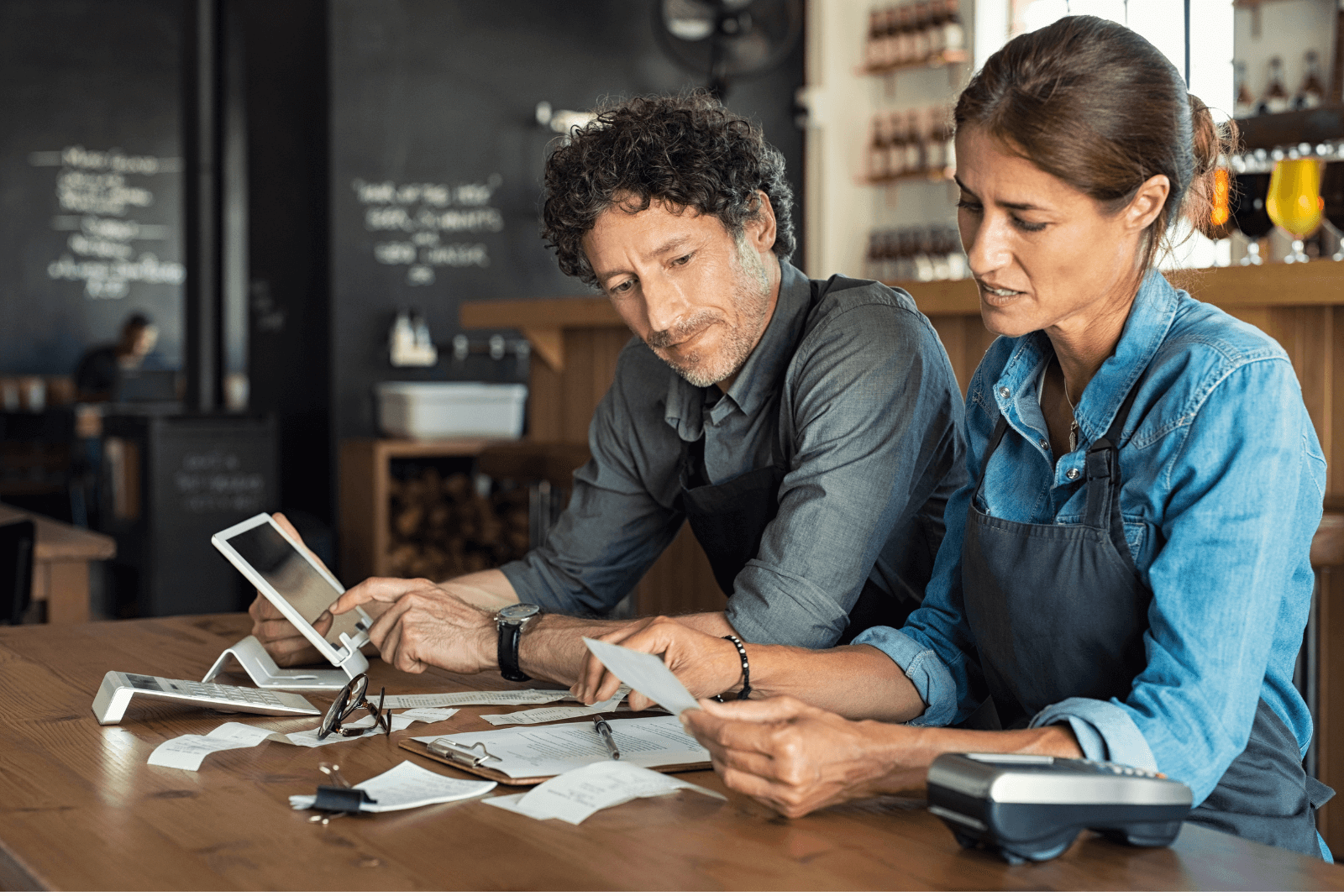
9 Reasons Why Your Restaurant Sales Might Be Down
